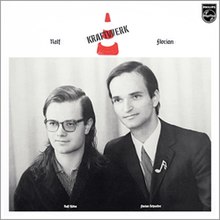Ralf and Florian
| Ralf und Florian | ||||||||||
|---|---|---|---|---|---|---|---|---|---|---|
 |
||||||||||
| Studio album by Kraftwerk | ||||||||||
| Released | October 1973 (DEU) released later in other countries |
|||||||||
| Recorded | May–July 1973 | |||||||||
| Studio |
Various
|
|||||||||
| Genre | ||||||||||
| Length | 37:41 | |||||||||
| Label | ||||||||||
| Producer | ||||||||||
| Kraftwerk chronology | ||||||||||
|
||||||||||
| Professional ratings | |
|---|---|
| Review scores | |
| Source | Rating |
| Allmusic | |
Ralf und Florian (English title: Ralf and Florian) is the third studio album by the German electronic band Kraftwerk. It was released in October 1973 on Philips.
Along with Kraftwerk's first two albums, Ralf und Florian to date has never been officially re-issued on compact disc. However, the album remains an influential and sought-after work, and bootlegged CDs were widely distributed in the 1990s on the Germanofon label. The band hinted that the album may finally see a re-mastered CD release after issuing the box set The Catalogue in the autumn of 2009.
As indicated by the title (and like their previous album), all the tracks were written, performed and produced by Ralf Hütter and Florian Schneider, with the sessions engineered by the influential Konrad "Conny" Plank. The album has a fuller and more polished sound quality than previous efforts, and this is clearly due to the use of a number of commercial recording studios in addition to Kraftwerk's own yet-to-be-named Kling Klang. The colour photograph on the back of the cover gives a vivid impression of the bohemian state of Kraftwerk's own facilities at the time – including egg-box trays pasted, nailed, or stuck on the walls as acoustic treatment.
The album is still almost entirely instrumental (some wordless vocalising appears in "Tanzmusik", and "Ananas Symphonie" features the band's first use of a machine voice created by an early prototype vocoder, a sound which would later become a Kraftwerk trademark). Instrumentation begins to show more obvious use of synthesizers (Minimoog and EMS Synthi AKS), but most melodic and harmonic keyboard parts are performed on Farfisa electronic piano/organ. Flute and guitar are still much in evidence. The band were still without a drummer, and several tracks, particularly "Tanzmusik", make use of a preset organ rhythm machine. "Kristallo" features a striking rhythmic electronic bassline (actually created on the EMS synthesizer with the aid of the vocoder), however in general the album is much gentler and less rhythmically precise than Kraftwerk's later electronic work.
The LP included a "musicomic" poster insert of cartoons by Emil Schult, who had been playing electric violin live with the band (although he does not feature on the album recordings). Schult remained a collaborator of Kraftwerk. The cartoons illustrated each track on the album, as well as the city of Düsseldorf, with the caption "In Düsseldorf am Rhein, klingt es bald!", which translates literally in English as "In Düsseldorf on the Rhine, it will sound soon" (perhaps the phrase "the sound gets around" captures the snappy feel of the maxim better). This is kind of a reference to Kraftwerk's Düsseldorf-based Kling Klang studio.
...
Wikipedia

